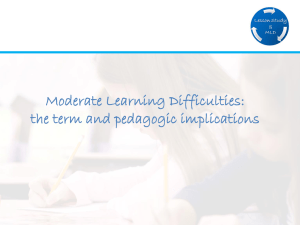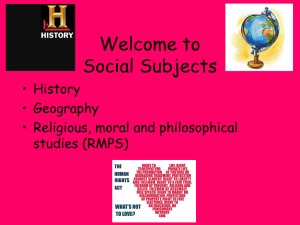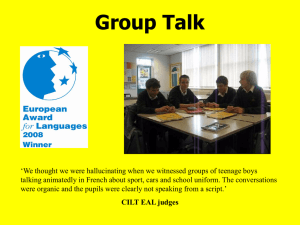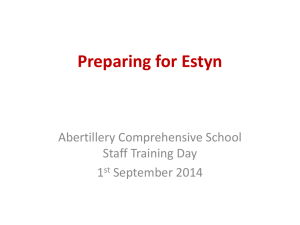Moderate learning difficulties
advertisement
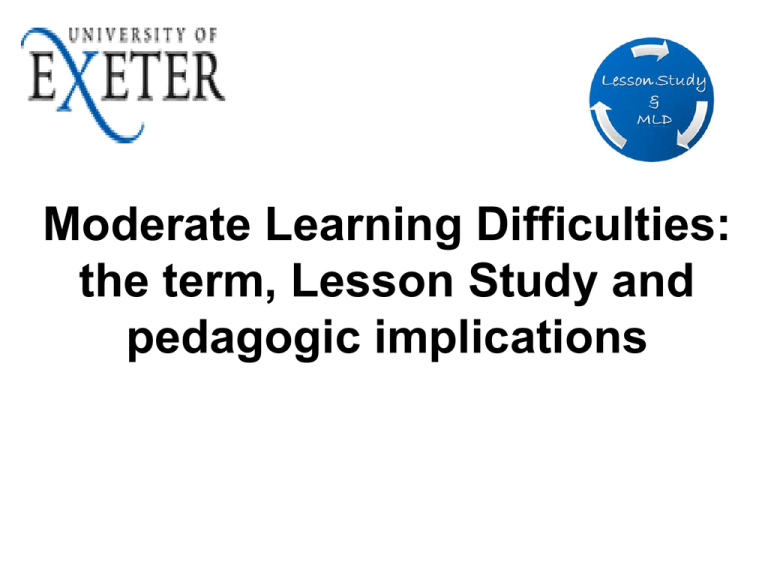
Moderate Learning Difficulties: the term, Lesson Study and pedagogic implications Rationale for study - pupils with moderate learning difficulties (MLD) represent the largest proportion of those identified as having special educational needs in the school system, Neglected as a focus for educational initiatives. - 25% of all pupils identified as having SEN at school action plus or with Statements in ordinary and special schools Neglect attributed to several factors. – come disproportionately from families who experience socioeconomic disadvantage – no well established advocacy or voluntary group dedicated to the interests of these pupils – historic uncertainty about pupils with MLD : between those with severe intellectual disabilities and ‘normal’ pupils who are lower attaining – = Moderate learning difficulties: 1. Not low attainment – not severe intellectual disability 2. Traditionally defined in IQ terms : 50/55-70 range 3. Subject to much critique – ethnic / cultural bias/ use of IQ; intelligence tests 4. Terminology changes/sensitivity: Mental deficiency, Educational imbeciles, Feeble minded, Mild /moderate educational subnormal, Educational mentally retarded, Mild/moderate intellectual disability 5. Terms and meaning vary internationally 6. Socially constructed term – serving dominant interests 7. Raises questions about : what is special education, who needs it? 8. ‘Acid test’ of inclusion policies. Definition of MLD: DfES, 2003 Pupils with moderate learning difficulties will have attainments significantly below expected levels in most areas of the curriculum, despite appropriate interventions. Their needs will not be able to be met by normal differentiation and the flexibilities of the National Curriculum. They should only be recorded as MLD if additional educational provision is being made to help them to access the curriculum. Pupils with moderate learning difficulties have much greater difficulty than their peers in acquiring basic literacy and numeracy skills and in understanding concepts. They may also have associated speech and language delay, low self-esteem, low levels of concentration and under-developed social skills.” MLD definition and identification Area Child functioning Significant low attainment in most areas of curriculum Sub-area Literacy numeracy Other e.g. science Much greater difficulty in understanding concepts Verbal and non-verbal reasoning: verbal concepts Speech and language delay Age level dependent Low self esteem Low level of concentration Under-developed social skills Environmental factors School attendance Additional teaching programmes MLD definition and identification: Child functioning Significant low Numeracy / literacy attainment in most areas of curriculum Options 1 Centile cut off for standardised test (e.g. below 5th centile) 2 Teacher assessed level (e.g. defined level below expected level (varies according to age) 3 SAT level (test results) e.g. defined level below expected level (varies according to age) Other e.g. science Much greater difficulty in Verbal and nonunderstanding concepts verbal reasoning: verbal concepts Similar options as above 1 Teacher assessment (year/class group referenced e.g. lowest 1-2 ) 2 Cognitive ability tests (On CAT, WISC, BAS e.g. lowest 2-5 centile) 3 Dynamic assessment (teaching assessment; teacher assessment based on degree of gain in response to assistance) Table 1: Crowther et al. (2001) system for defining MLD Associated with No other significant difficulties Significant emotional and behavioural difficulties Significant sensory/medical difficulties Milder learning difficulties More severe learning difficulties Concept map of themes in LEA definitions’ of MLD term not use term low cognitive ability associated difficulties not SLD nor SpLD MLD specify cut-off low attainment and ability low attainment cross curriculum DCSF (2010) % of pupils with Statements/SA+ in each areas of SEN achieving level 4+ in Eng and Maths % numbers Specific LD 22.7 9,042 Moderate LD 11.1 19,480 Beh, Emot Soc D 36.2 12,116 Visual Impairment 52.5 652 3 prototypes (research on LA use) : 1. definitions in terms of low curriculum attainments (all / a number), with cut-offs specified and with associated areas of difficulties; 2. definitions in terms of low attainments AND cognitive abilities, with cut-offs specified, distinguished from severe and specific learning difficulties and with associated areas of difficulties; 3. not use MLD term. Phase 1 research shows: - Pupils identified by secondary schools as having MLD fall into 3 subgroups groups and illustrated (Ylonen and Norwich 2011): • Those with low attainment and low concept understanding and reasoning (model 1) • Those with low attainment only (model 2) • Identified as MLD but not with low attainment nor concept understanding/ reasoning (model 3). These findings suggest that some pupils are identified as having MLD inappropriately (group 3), while for others ‘conceptual understanding and reasoning’ are not used as indicators of MLD. BAS matrices and verbal similarities (reasoning) T-scores (%) Score of under 30 = in the lowest 2% of age group Score between 31-40 = in the lowest 2-16% of age group Score between 41-50 = 17-50% Score of 51 and above = 50% + (above average) BAS spelling and reading (literacy) standard scores (%) Scores below 70 = in the lowest 2% of age group Scores between 70.5-85 = in the lowest 2-16% Scores between 85.5 and 100 = 17-50% Scores of 100.5 and above = 50% + (above average) Is there a difference between MLD, low attainment and specific learning difficulties SpLD? - depends on definition: i. attainment only OR ii. attainment AND cognitive ability - MLD as general learning difficulty; SpLD as specific difficulty - categoric versus dimensional (continuum position) - dimensional with pragmatic cut offs Specific – general learning difficulties Uneven attainments Even attainments Specific General LD: MLD LD CUT OFFS? MLD low attaining average attaining Range of attainments high attaining Why use the term MLD? Is it a disability, like severe learning diffiuclties? Or is it just very low attainment? - Raises dilemma about differentiating this group 1.If do we identify MLD as an area of SEN / disability? Risks – negative labelling, false identification as disability/SEN 2. If do we not identify it as difficulty / disability but as part of the continuum of attainment? Risks – overlook rights / needs of some vulnerable pupils, lose additional resources 3 options for resolving dilemma: 1. Retain and specify MLD category as an area of SEN 2. Abandon MLD as a SEN category: consider as very low attainment provide in terms of compensatory education / social inclusion framework. 3. Abandon MLD for majority, redefine new tighter category of mild mixed difficulties for minority. What positive difference does this make for teaching? Is there a specific set of MLD relevant teaching strategies? - Little research; what written suggests no MLD specific pedagogy teaching (Fletcher-Campbell, 2004) - various teaching approaches relevant to MLD but also relevant to pupils with lower attainment Continua of pedagogic strategies: - appropriate teaching as - intensification and more focussed extension - of general teaching approaches (Lewis and Norwich, 2004) Model of teaching strategies (from phase 1 research) • Broad pedagogic approach: – Pedagogic methods/assumptions – Activity based learning – Assessment for learning • Input (multi-modal/sensory approaches) • Cognitive demand: – Level/style (differentiation) – Memory/consolidation • Motivational approaches • Learning relationships – Grouping and peer support – Adult-pupil communication • Working with additional adults Pedagogic approaches Specialist/SEN Generic adapted/ Low attaining to above average Is there a specialist pedagogy for MLD? Generic intensified / SEN Generic adapted/ Low attaining to above average Evaluation of phase 1 Lesson Study Processes: more than 90% of teachers agreed with mostly/definitely • Novelty and practical relevance of LS makes you interested in lesson development for pupils with MLD • wider awareness of LS process enhances confidence in teaching pupils with MLD • LS provides micro-focus on learning of 1-2 students to enable greater depth of analysis • participating teachers feel less threatened to scrutinise their teaching by focusing on pupil learning rather than evaluating teaching. • LS enables participating teachers to think about themselves as innovators in their schools. Evaluation of phase 1 Lesson Study Outcomes: more than 90% of teachers agreed with mostly/definitely • more theoretical and practical knowledge about LS • more understanding about nature and complexity of the learning needs of pupils with MLD. • increased capability to plan and differentiate in your teaching of pupils with MLD • more confidence to try out novel teaching approaches in lessons • LS process has improved the quality of planning of your teaching (not just how to refine specific lesson.) Lesson Study methodology components: -developing ground rules for working in joint research mode, • using case pupils (small number of pupils around whom the development is focussed), • identifying what to learn and why; the research focus, • drawing on what has been learned already about this focus, • joint planning, • joint observation (data capture) • analysing and recording of what has been learned from case pupils and by researchers, • capturing and distilling practice / data (through using videos, stills and audios) • finding ways of helping others to learn from what has been learned (innovated, refined, modified), •creating an artefact to communicate this (e.g. powerpoint, video, coaching guide, etc.) and using it. What do we know about focus on MLD that is relevant to Lesson Study developments? Studies indicate : 1. weaker intellectual abilities; reasoning, problem solving, thinking skills etc. 2. weaker working memory: phonological, spatial, executive control 3. issues about self esteem, motivation and independent learning Way forward: adopt research based ideas and practices to inform the review and planning aspects of Lesson Study - Thinking skills - Motivation strategies - Working memory supports 1. Thinking skills: National Curriculum thinking skills: 1. Information processing, e.g. sort and classify 2. Reasoning e.g. draw inferences and make deductions 3. Enquiry, e.g. ask relevant questions 4. Creative thinking, e.g. generate and extend idea 5. Evaluation, e.g. judge the value of what they read, hear and do 2. Motivation strategies ARCS model (Keller) Design guidelines for developing effective motivational strategies Attention Relevance Confidence Satisfaction ARCS model: expectancy – value model ATTENTION - perceptual arousal - inquiry arousal - variability /novelty RELEVANCE - goal orientation - motive matching - learning requirements - success opportunities - personal responsibility - intrinsic reinforcement - extrinsic rewards - equity CONFIDENCE SATISFACTION Motivational observation/interviewing schedule: Based on areas arising from Motivation Survey based on ARCS - Areas to be used for classroom observation and interview of pupils about their motivation - focus on individual and/or group - on project website Working memory : Working Memory and Learning: A Practical Guide for Teachers Gathercole and Alloway Sage. Working memory questionnaire for teachers Strategies: 1. Recognise working memory failures 2. Evaluate the working demands of learning activities 3. Reduce working memory loads if necessary 4. Frequently repeat important information 5. Encourage the use of memory aids Working memory guide on MLD LS website under resources Using these research informed approach in your Lesson Study in your subject • What opportunities are there in the lesson that you are focusing on in Lesson Study to integrate teaching that promotes • Motivation strategies? • Thinking skills? • Monitor and use working memory strategies? Slide 3.7 30
